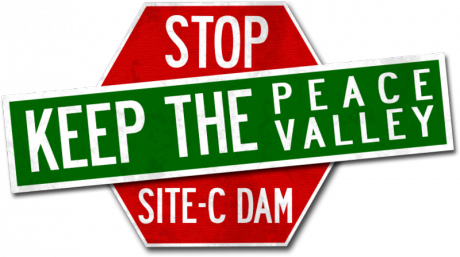News
You are here
Site C dam: “this project and its impacts far outweigh any benefits.”

April 1, 2015
In December 2014 British Columbia’s Liberal government approved the Peace River Site C hydroelectric dam project, the third dam on the Peace River. With a current price tag of $8.8 billion and rising, the project is promoted as a necessary “clean, renewable, cost-effective electricity” project that will bring “benefits for communities and First Nations.”
As usual with Liberals, none of their claims are true.
Indigenous sovereignty
Liz Logan, Treaty 8 Chief, in a January 2014 interview said, “We just ask that there be balance, and development be done with as minimal impact as possible. In the case of Site C, this project and its impacts far outweigh any benefits.” The Peace River and the dam site are on the lands of The Treaty 8 First Nations. Under Treaty 8, signed in 1899, First Nations in the area were guaranteed the right to hunt and fish “for as long as the sun shines, the rivers flow and the grass grows.” This has meant that First Nations must be included in decisions relating to industrial development on their lands.
The government’s own Joint Review Panel reports that there will be “significant adverse effects” on fishing, hunting, trapping and other traditional land uses. A review by the BC Utilities Commission concluded in October 2014 that First Nations impacts cannot be mitigated. The dam will obliterate 337 recorded archaeological sites and many unrecorded ones. This will result in untold cultural loss for the regions First Nations, hindering their cultural and traditional practices. For all of these reasons the Treaty 8 First Nations oppose the construction of the dam.
Rationale
Since the 2010 announcement that the Site C project will go ahead, the BC government has changed its rationale for it several times. At first, the electricity was to be to power BC homes. But as BC became an exporter of electricity, the reason shifted to providing energy for the proposed liquefied natural gas (LNG) industry. This is contrary to what BC Hydro said in the Joint Review Panel hearings, that excess power from the dam will be exported to California. Currently, the Site C project is being sold to British Columbians as something that will “provide clean energy for the next 100 years.”
Site C will provide 1100 MW of capacity, about 5100 GWh of electricity per year by the project’s 2024 completion. This is enough to power approximately 450 000 homes. Overall, Site C is projected to provide about 20% of the electricity produced in the province. There is no evidence that demonstrates BC has a need for this additional capacity.
The Joint Review Panel reported that need for the energy produced by Site C was not conclusively demonstrated. BC Hydro’s reports say that it is likely current and future demand can be met with energy conservation measures, such as lower rates for electricity use in off-peak times of day. The Premier has said that Site C is needed to power expansion in BC’s natural gas industry. This makes Site C a subsidy for resource extraction.
Flooding
Construction of the dam will result in the flooding of the river valley, creating a reservoir 83km long, and covering an area equivalent to that of the city of Ottawa. This valley is one of the last remaining “wild” sections of the Peace River, and has much land use potential.
The valley is class 1 and 2 agricultural land, and represents the best agricultural land in northern BC. Class 1 soils are the most nutrient-rich and under good management are the most highly productive soils for a wide range of field crops. This is the only class 1 soil north of the city of Quesnel. In a world facing food security concerns due to climate change, we should not destroy prime agricultural land.
The area to be flooded by the dam is 3000 hectares of wildlife habitats, significantly habitat for grizzly bears, wolverine and caribou. This area is a section of the important wildlife corridor in the Yellowstone to Yukon corridor chain. The old-growth boreal forest is important for not only wildlife habitat, but as a carbon sink.
Site C faills to meet the minimum international standards for large dam construction as proposed by the World Commission on Dams.
Climate change
Although the BC government is presenting Site C as a “clean energy project”, hydroelectricity is not clean and green. Site C will increase the province's annual greenhouse gas emissions by about 150 000 tonnes. The increase will result from three main things: the carbon footprint of the construction process; decay of the flooded out boreal forest vegetation; and that the power will be used by fracking operations in northeast BC and by those developing Alberta’s tar sands.
Site C is not cost efficient. There are predictions that the cost to produce electricity will be up near $100 / MWh, while the sale price to the North American grid will be near $35/MWh, a huge loss.
If there is a need for increased energy capacity in BC renewable energy sources could make up the difference. Wind, solar and geothermal energy – coupled with conservation measures – are all feasible alternatives.
Alternatives
The Canadian Geothermal Energy Association (CGEA) released a paper in November 2014. Titled “Geothermal Energy: The Renewable and Cost Effective Alternative to Site C”, the report showed that geothermal electricity could be competitive with the costs of Site C, and likely cost less. As the Joint Review Panel mentioned in its report, BC Hydro’s “failure to pursue research over the last 30 years into BC’s geothermal resources” left it “without information” about a resource that “may offer up to 700MW of firm, economic power with low environmental costs.”
According to the CGEA, 700MW is at the low end of possible geothermal energy production estimates. Their report shows that geothermal has lower energy and capital cost, produces more permanent jobs, has minimal need for transmission upgrades, and has lower greenhouse gas emissions.
First Nations' rights should not be ignored, our remaining thriving ecosystems should not be flooded, agricultural land must be protected and the climate crisis requires building truly clean energy sources. Site C must be stopped.
If you like this article, register for Rage Against the System, a weekend conference of ideas to change the world, April 24-26 in Toronto. Sessions include "Colonialism and Indigenous resistance" and "The fight for climate jobs."
Section:










